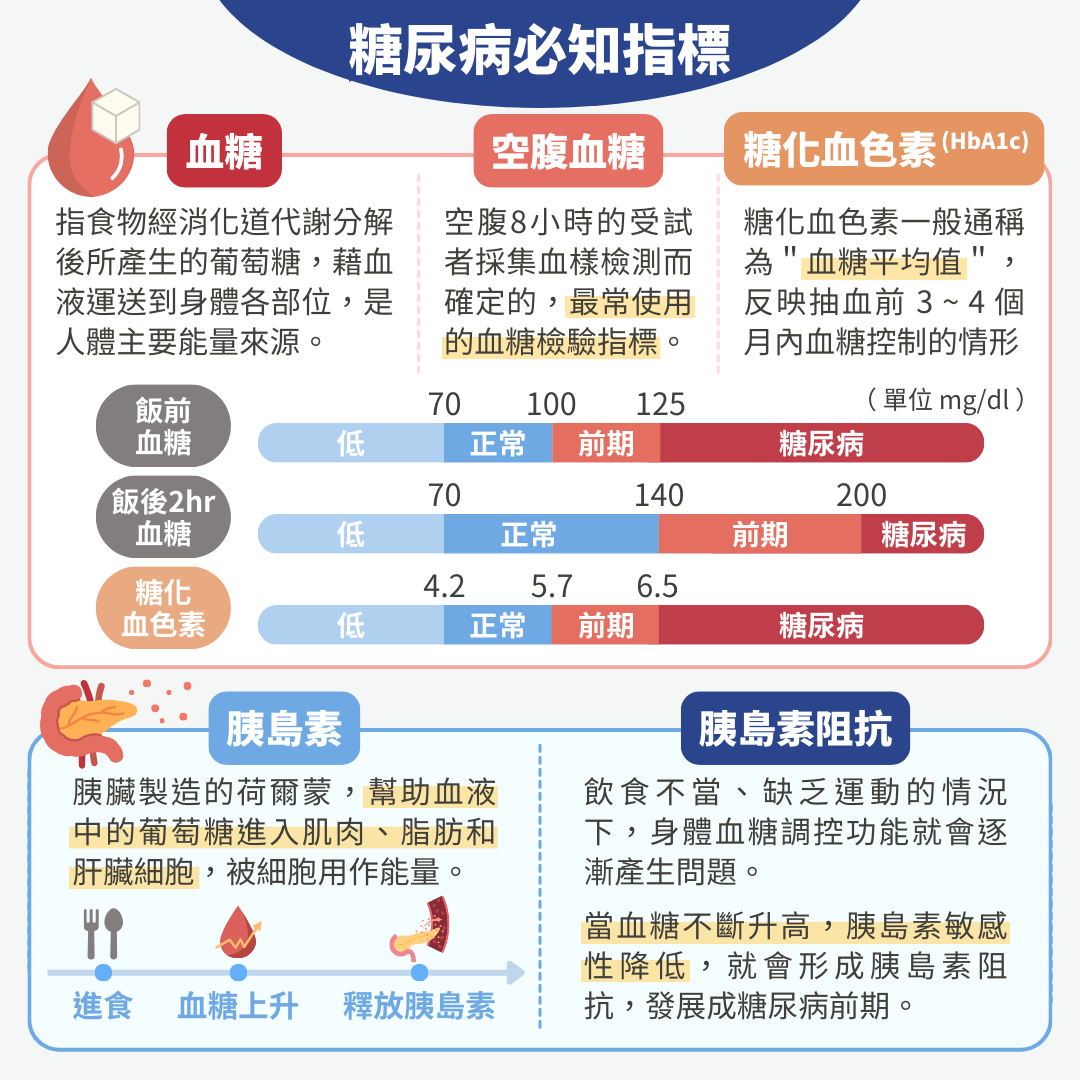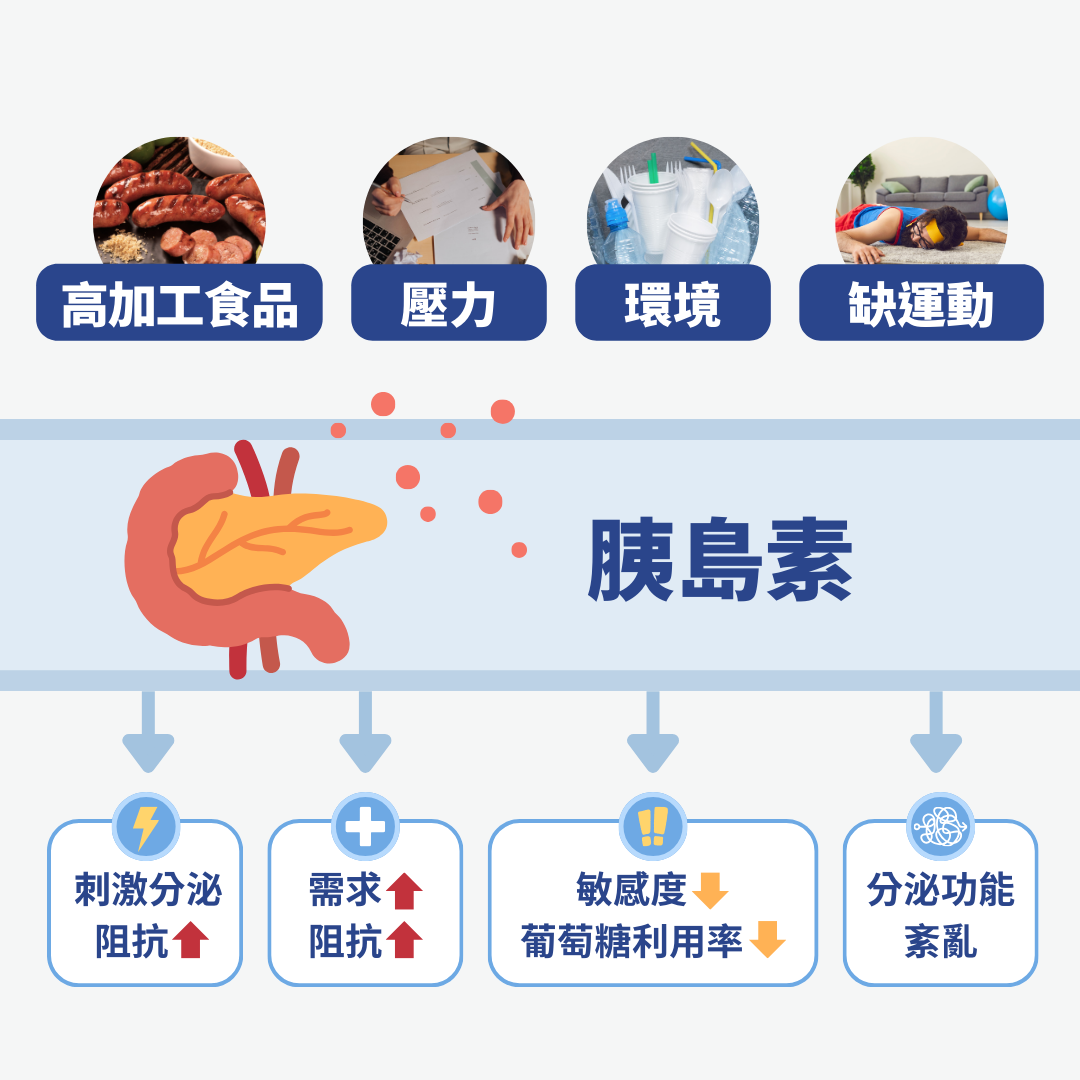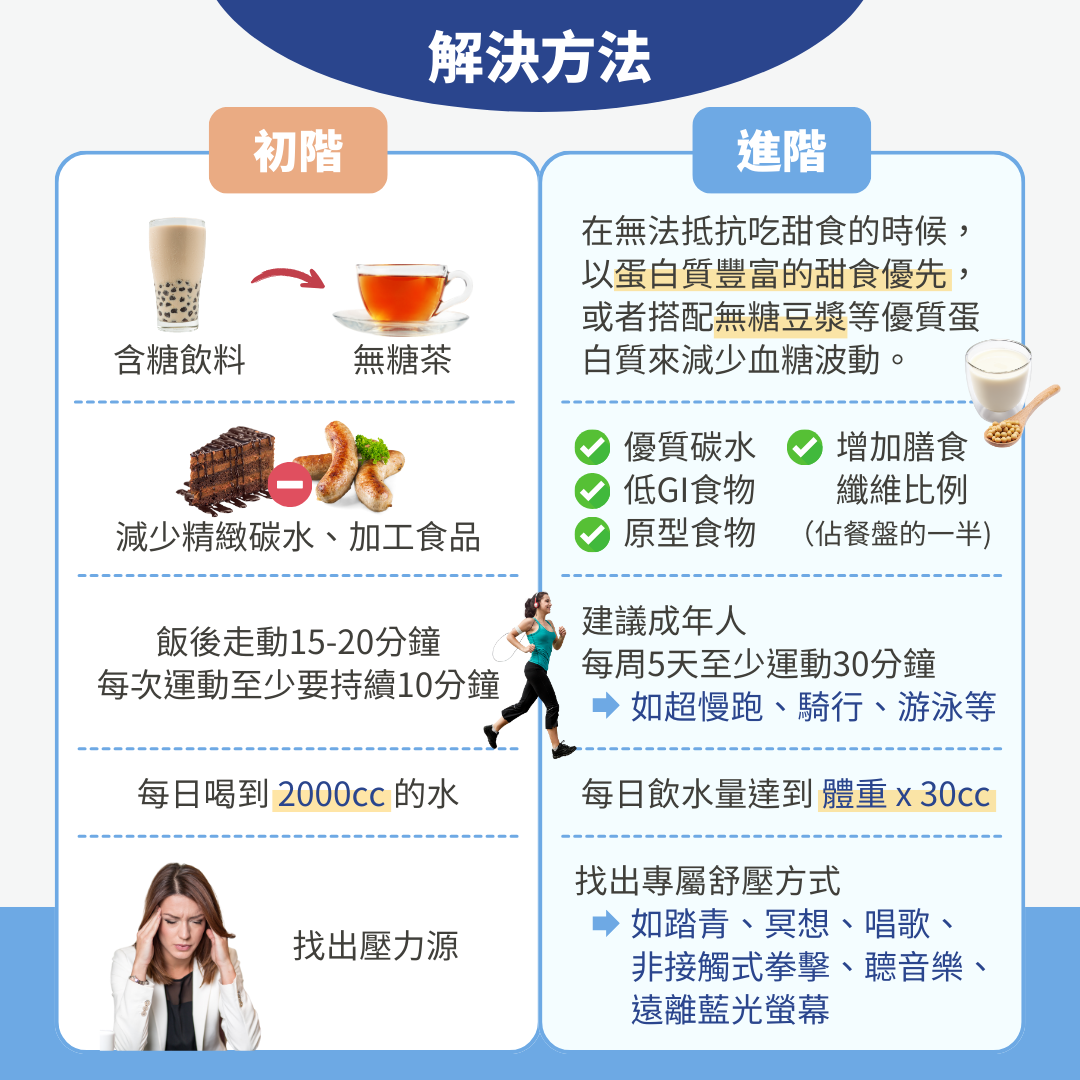糖尿病正在年輕化?
醫師呼籲:飲食作息需改變!
作者|初日診所 周建安醫師
很多人以為年輕就是本錢,只有年紀大才會得糖尿病?但事實上隨著生活型態的變化,近年來飲食選擇越來越多樣且精緻,也有各種數據都顯示著「糖尿病正在年輕化」!今天,將由 初日診所-周建安 醫師 來分享糖尿病的診斷標準、外顯症狀、風險因子,以及改善策略...等,讓我們學習以正向態度面對糖尿病。
我有糖尿病嗎?糖尿病必知 5 指標
血糖:指食物代謝後產生的葡萄糖,正常範圍內的血糖是人體主要能量來源。
空腹血糖:至少空腹8小時後的血糖水平,是最常用的檢驗指標。
糖化血色素(HbA1c):反映過去3-4個月內的血糖控制情況。
胰島素:胰臟製造的荷爾蒙,幫助血液中的葡萄糖進入細胞,被用作能量。
胰島素阻抗:細胞對胰島素反應不佳,導致血糖無法進入細胞,長期下來會發展成糖尿病。
![我有糖尿病嗎?糖尿病必知 5 指標 血糖:指食物代謝後產生的葡萄糖,正常範圍內的血糖是人體主要能量來源。 空腹血糖:至少空腹8小時後的血糖水平,是最常用的檢驗指標。 糖化血色素(HbA1c):反映過去3-4個月內的血糖控制情況。 胰島素:胰臟製造的荷爾蒙,幫助血液中的葡萄糖進入細胞,被用作能量。 胰島素阻抗:細胞對胰島素反應不佳,導致血糖無法進入細胞,長期下來會發展成糖尿病。]() 糖尿病的診斷標準及監測指標:除了「空腹血糖」之外,還有「糖化血色素」、「胰島素阻抗」
糖尿病的診斷標準及監測指標:除了「空腹血糖」之外,還有「糖化血色素」、「胰島素阻抗」
糖尿病外顯 5 症狀,有這些徵兆要警覺!
黑色棘皮症:皮膚皺褶處如脖子、腋下變黑變厚,是胰島素阻抗的標誌。
三多症狀:吃多、喝多、尿多。血糖上升,身體排糖過程中也會排出大量水分,導致口渴。
疲憊:血糖過高導致能量不足,身體感到疲勞倦怠。
體重下降:高血糖引起的脫水導致體重快速下降。
傷口難癒合:高血糖使免疫細胞無法有效到達傷口,容易感染。
![糖尿病外顯 5 症狀,有這些徵兆要警覺! 黑色棘皮症:皮膚皺褶處如脖子、腋下變黑變厚,是胰島素阻抗的標誌。 三多症狀:吃多、喝多、尿多。血糖上升,身體排糖過程中也會排出大量水分,導致口渴。 疲憊:血糖過高導致能量不足,身體感到疲勞倦怠。 體重下降:高血糖引起的脫水導致體重快速下降。 傷口難癒合:高血糖使免疫細胞無法有效到達傷口,容易感染。]() 糖尿病暗藏的5大症狀,你中了幾項?
糖尿病暗藏的5大症狀,你中了幾項?
增加罹患糖尿病機率的 5 大危險因子
不良飲食習慣與肥胖:高糖、高脂肪和高熱量的食物增加血糖水平。
缺乏運動:運動不足會降低胰島素敏感性,導致血糖升高。
遺傳因素:家族有糖尿病病史,個人罹患風險增加。
壓力與荷爾蒙:壓力引發荷爾蒙變化,增加胰島素需求。
環境因素:環境荷爾蒙可能影響胰島素分泌功能。
![增加罹患糖尿病機率的 5 大危險因子 不良飲食習慣與肥胖:高糖、高脂肪和高熱量的食物增加血糖水平。 缺乏運動:運動不足會降低胰島素敏感性,導致血糖升高。 遺傳因素:家族有糖尿病病史,個人罹患風險增加。 壓力與荷爾蒙:壓力引發荷爾蒙變化,增加胰島素需求。 環境因素:環境荷爾蒙可能影響胰島素分泌功能。]() 糖尿病患者出現「胰島素阻抗」的 5 大肇因
糖尿病患者出現「胰島素阻抗」的 5 大肇因
為什麼會產生胰島素阻抗?
高糖、高油脂、加工食品會刺激更多胰島素分泌
運動量減少,降低胰島素敏感度,同時減少體内葡萄糖的利用率
遺傳病史會增加罹患糖尿病風險
壓力造成身體對於胰島素需求增加,提升胰島素阻抗風險
環境荷爾蒙造成胰島素分泌功能紊亂
![為什麼會產生胰島素阻抗? 高糖、高油脂、加工食品會刺激更多胰島素分泌 運動量減少,降低胰島素敏感度,同時減少體内葡萄糖的利用率 遺傳病史會增加罹患糖尿病風險 壓力造成身體對於胰島素需求增加,提升胰島素阻抗風險 環境荷爾蒙造成胰島素分泌功能紊亂]() 當胰島素阻抗發生時作用如上:糖尿病前期的惡循環
當胰島素阻抗發生時作用如上:糖尿病前期的惡循環
改變飲食作息,有效降低糖尿病風險
「初階」解決方法:
含糖飲料換成無糖茶
減少精緻碳水、加工食品
飯後走動15-20分鐘
每日喝2000cc的水
找出壓力源
「進階」解決方法:
蛋白質豐富的甜食優先
選擇低GI食物和原型食物,增加膳食纖維比例
每周運動至少5天,每次30分鐘
尋找適合的運動方式,如慢跑、騎行、游泳
找出專屬的舒壓方式,如踏青、冥想、唱歌等
![改變飲食作息,有效降低糖尿病風險 「初階」解決方法: 含糖飲料換成無糖茶 減少精緻碳水、加工食品 飯後走動15-20分鐘 每日喝2000cc的水 找出壓力源 「進階」解決方法: 蛋白質豐富的甜食優先 選擇低GI食物和原型食物,增加膳食纖維比例 每周運動至少5天,每次30分鐘 尋找適合的運動方式,如慢跑、騎行、游泳 找出專屬的舒壓方式,如踏青、冥想、唱歌等]() 控制血糖5原則,先從初階策略開始著手!
控制血糖5原則,先從初階策略開始著手!
真實案例分享:年輕族群更應及早控制血糖
這是一名19歲的大學生,身高173公分,體重110公斤,從小到大一直超重。他原本只是為了減重來到門診,卻發現血糖超高,糖化血色素(HbA1c)達到9,血脂、尿酸和肝功能也都不正常。深入了解後發現,他每天吃速食,份量是一般人的兩倍,還每天喝全糖飲料,不喝水,再加上繁重的學業壓力,幾乎不運動,最終導致糖尿病。
 糖尿病友實例:年輕就是本錢?錯誤的生活習慣、糟糕的飲食型態,恐導致提早確診糖尿病!
糖尿病友實例:年輕就是本錢?錯誤的生活習慣、糟糕的飲食型態,恐導致提早確診糖尿病!
這名大學生的故事提醒我們,不良的生活方式和飲食習慣可能導致嚴重的健康問題。通過改善飲食和增加運動,我們可以有效降低患糖尿病的風險。
※ 番外篇:想了解自己是否有荷爾蒙異常、或解決肥胖症問題?

每個人的天生體質、飲食習慣還有體態目標都不一樣,尋求醫生和營養師的協助,評估個人狀況,再規劃飲食內容,才能在不對身體造成傷害的狀況下,健康瘦下來!如果你有需要醫師與營養師為你規劃減脂/減重的計劃,歡迎預約周建安醫師的控糖減肥門診,為你進行胰島素阻抗嚴重度評估、脂肪肝超音波減查、個人生理數值包含體重、體脂、肌肉量、內臟脂肪等重要指標的檢測,並指導你的個人化飲食。
前往預約
參考資料
- “Testing for Diabetes.” Centers for Disease Control and Prevention, Centers for Disease Control and Prevention, www.cdc.gov/diabetes/diabetes-testing/index.html. Accessed 27 May 2024.
“Indicator Metadata Registry Details.” World Health Organization, World Health Organization, www.who.int/data/gho/indicator-metadata-registry/imr-details/2380. Accessed 27 May 2024.
Little, Randie R, and David B Sacks. “HbA1c: How do we measure it and what does it mean?” Current Opinion in Endocrinology, Diabetes & Obesity, vol. 16, no. 2, Apr. 2009, pp. 113–118, https://doi.org/10.1097/med.0b013e328327728d.
“Insulin Resistance & Prediabetes - Niddk.” National Institute of Diabetes and Digestive and Kidney Diseases, U.S. Department of Health and Human Services, www.niddk.nih.gov/health-information/diabetes/overview/what-is-diabetes/prediabetes-insulin-resistance#insulinresistance. Accessed 27 May 2024.
“Understanding Carbs.” Carbs and Diabetes | ADA, diabetes.org/food-nutrition/understanding-carbs. Accessed 27 May 2024.
Van der Velde, Jeroen H., et al. “Timing of physical activity in relation to liver fat content and insulin resistance.” Diabetologia, vol. 66, no. 3, 1 Nov. 2022, pp. 461–471, https://doi.org/10.1007/s00125-022-05813-3.
Sharma, Kapil, et al. “Stress-induced diabetes: A Review.” Cureus, 13 Sept. 2022, https://doi.org/10.7759/cureus.29142.
Kim, Shin-Hye, and Mi-Jung Park. “Effects of growth hormone on glucose metabolism and insulin resistance in human.” Annals of Pediatric Endocrinology & Metabolism, vol. 22, no. 3, 30 Sept. 2017, pp. 145–152, https://doi.org/10.6065/apem.2017.22.3.145.
Schulz, Margaret C., and Robert M. Sargis. “Inappropriately sweet: Environmental endocrine-disrupting chemicals and the diabetes pandemic.” Endocrine-Disrupting Chemicals, 2021, pp. 419–456, https://doi.org/10.1016/bs.apha.2021.04.002.
“糖尿病前期是可以改善!醫教你如何靠運動和飲食控制逆轉最後機會|元氣網.” 元氣網-解決你的健康大小事|元氣網, 元氣網, 12 Nov. 2023, health.udn.com/health/story/5974/7192985.
國民健康署 生活化運動
Bozdarov, Johny, et al. “Boxing as an intervention in mental health: A scoping review.” American Journal of Lifestyle Medicine, vol. 17, no. 4, 9 Sept. 2022, pp. 589–600, https://doi.org/10.1177/15598276221124095.
Linnemann, Alexandra, et al. “Music listening as a means of stress reduction in daily life.” Psychoneuroendocrinology, vol. 60, Oct. 2015, pp. 82–90, https://doi.org/10.1016/j.psyneuen.2015.06.008.
Nakshine, Vaishnavi S, et al. “Increased screen time as a cause of declining physical, psychological health, and sleep patterns: A literary review.” Cureus, 8 Oct. 2022, https://doi.org/10.7759/cureus.30051.
「兩個月暴瘦10公斤已罹癌?「全身器官泡糖水」確診糖尿病|初日診所周建安醫師【TODAY健面聊】(上集 )」影片線上看
「長期高血糖鐵齒不就醫 打噴嚏視力剩0.2?險終生洗腎|初日診所周建安醫師【TODAY健面聊】(下集 )」影片線上看
初日醫學
聯絡方式
地址|台北市中山區民生東路二段163號4樓
時間|週一至週五 10:00 - 18:00




